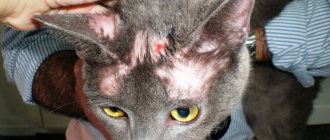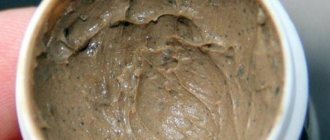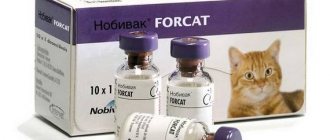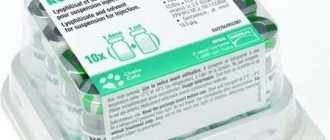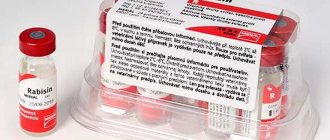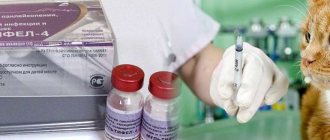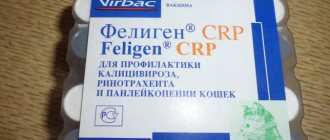In order for your pet to grow up healthy, you need to follow certain procedures to prevent it from contracting infections.
There are mandatory vaccinations in accordance with the requirements of the legislation of the Russian Federation, for example, a rabies vaccination. There are also necessary vaccinations - comprehensive vaccination against the most common viral diseases, these are paleukopenia, rhinotracheitis, calicivirosis,
At the owner's request, it is possible to be vaccinated against chlamydia and viral leukemia, if the animal lives in an area unfavorable for these diseases. Also one of the additional vaccinations is the shingles vaccine.
Vaccination schedule by age for cats and kittens>>>
For vaccination to be successful, certain conditions must be met, failure to comply with which may harm the cat.
Vakderm for cats: vaccine against lichen
To prevent a cat from getting lichen or other dangerous fungal diseases localized on the skin, a conscientious owner must vaccinate on time. One of the affordable and highly effective products used for the prevention and treatment of dermatophytoses is Vakderm for cats. This medicine helps to develop strong immunity in the animal and prevent infection upon contact with carriers of lichen.
Operating principle
The main component of the drug Vakderm F for cats is spores of dermatophyte fungi in inactivated form. These fungi will not cause any harm to the body of a healthy animal; preventive vaccination will protect the pet from trichophytosis and microsporia. The protective effect of the vaccine will last for a whole year.
If the injection is given to a cat that has already been infected with a fungal infection, but does not yet have symptoms, after the administration of the veterinary drug, lesions will appear on the animal’s body (bald patches, peeling skin, scabs, etc.). 2-3 weeks after the second vaccination, which is usually given 10-14 days after the first injection, the disease will begin to recede, the skin will clear, and new hair will grow at the site of the lesions.
The drug Vakderm is available in two forms: as a liquid solution or a yellow-brown powder. Both products are sold in ampoules of 1 milliliter.
Rules of application
Vakderm injections must be given according to certain rules. The instructions for use of the drug contain detailed instructions for vaccinating animals. The cat owner must follow these recommendations:
- the Vakderm vaccine is always given intramuscularly (in the thigh area);
- to achieve a preventive and therapeutic effect, the injection must be given twice, the interval between vaccinations should be 10-14 days (immunity to fungal diseases will begin to develop 20-30 days after the second vaccination);
- the first and second injections must be given in different limbs (one vaccine is placed in the right thigh, the other in the left, or vice versa);
- 10 days before the procedure, you need to give the cat anthelmintic medication;
- during vaccination, it is necessary to use disposable sterile syringes; it is best to lubricate the needle insertion area with alcohol;
- the dry vaccine must be diluted with saline solution, purified water (distillate) or a special diluent for vaccines, the medicine must be thoroughly mixed until smooth;
- the temperature of the finished solution should be approximately the same as body temperature (to warm up the vaccine, the ampoule can be held in warm palms for a while);
- a single dose for kittens up to 6 months is 0.5 milliliters, felines older than six months are given 1 milliliter of solution;
- owners should not use the drug after its expiration date;
- An ampoule that has been opened but not completely used cannot be stored or reused; any remaining medication must be disposed of immediately.
Contraindications
Injecting the Vakderm vaccine to cats is not recommended in the following cases:
- when body temperature rises;
- for any infectious diseases;
- with poor immunity;
- for chronic pathologies in the acute stage.
Also, cats should not be vaccinated in the second half of pregnancy.
In some cases, after vaccination, animals may develop a lump in the area where the vaccine was given. Usually this unpleasant symptom goes away after a few days. To avoid the appearance of puffiness and swelling, you should use sterile syringes and use medicine that is at body temperature.
Many owners notice that their pet becomes lethargic and drowsy after vaccination. This condition in most cases does not require medical attention and disappears on its own after a couple of days.
“Every year we vaccinate our cats against fungal infections. He often walks outside, so he cannot do without reliable protection against lichen and other skin diseases. We have been using Vakderm for vaccination for three years. This tool has never failed. Our pet is healthy, has a beautiful thick coat and clean skin. I recommend this drug to all beginning cat owners.” Konstantin, Moscow.
Analogs
In veterinary pharmacies you can find other preventive vaccines that protect cats from lichen. Analogues of Vakderm are such drugs as Microderm and Polivac.
What else to read
Comments
Dosage and method of administration
Vaccination must be regular.
There are certain vaccination instructions that must be followed.
- A week and a half before introducing Vakderm to an animal, it is necessary to poison the worms. To prevent parasites from reducing the animal’s immunity. Otherwise, the body will not cope with the vaccine and serious complications may occur.
- Take all necessary measures to ensure that excess microbes do not enter the animal’s body through wounds and destroy existing ones.
- Use only sterile medical instruments.
- Each needle is intended for only one animal.
- Treat the area where the syringe will be inserted to administer the medication with alcohol.
- Before administration, warm the container with its contents to the animal’s body temperature.
- Be sure to enter 2 times. Repeat in a year.
- If it was not possible to complete the procedure on time, it must be done as quickly as possible.
In order to vaccinate an animal, it is important to follow the dosage rules. Doses depend on the age of the pet. For small kittens, the dose is 0.5 ml. For adult cats 1 ml.
Causes and symptoms
The most important cause of ringworm infection is reduced immunity. Cows with high body resistance in the absence of provoking factors are rarely susceptible to infection. Other causes of the disease:
- Microtraumas of the skin.
- Unsanitary conditions in the premises.
- Close contact with a sick individual.
- Rodents in a stall.
Rodents in a stall
Let's look at how lichen manifests itself in a calf or an adult cow:
- Single or multiple lesions and bald spots appear on the body.
- The skin on them peels off, and crusts with a gray coating may appear.
- Subsequently, the affected area gradually increases.
- As a result of damage to the hair follicles by the fungus, hair falls out.
Possible complications
The vaccine manufacturer warns that after administration of Vakderm-F, the cat may become drowsy or have a fever. This state lasts a maximum of three days. Some owners note that a swelling forms at the injection site after vaccination. To speed up the resorption of the seal, it is recommended to lubricate the problem area once with an alcohol solution of iodine.
If a cat begins to noticeably show signs of lichen after vaccination, it means that the animal has already been infected and the incubation period has passed. In such a situation, after two weeks it is also necessary to re-inject the vaccine, maintaining the dosage according to the instructions for use. There are no more serious complications after Vakderm F.
Contraindications and side effects
According to the instructions, Vakderm for cats cannot be used in the following cases:
- for kittens under 1 month of age;
- in the second half of pregnancy;
- with hyperthermia (high temperature);
- for infectious diseases.
The drug should not be used for weakened animals or cats with chronic pathologies. In this case, the main treatment is carried out first, and then vaccinated.
Note! It is strictly forbidden to use Vakderm in combination with other vaccines, as well as medications that suppress the animal’s immunity.
Some animals may exhibit hypersensitivity to the drug. The following symptoms may indicate this:
- drowsiness;
- apathy;
- loss of appetite.
Drowsiness can also occur with an overdose. Special measures are usually not required in such cases, since the symptoms go away on their own. If your pet's condition has not improved within two days, be sure to contact your veterinarian.
Sometimes lumps appear at the injection site. They need to be treated once with tincture of iodine. If the compaction does not go away, a doctor's consultation is necessary. Otherwise, inflammation and even tissue necrosis may occur.
Complications and side effects
The dosage of the vaccine is calculated based on the age and weight of the individual animal. After the first administration, a deterioration in condition is considered a normal reaction: the dog looks lethargic and sleeps a lot. This temporary phenomenon does not require treatment. Also, at the site of vaccine administration, a local reaction develops in the form of a compaction, which completely resolves after 5-7 days. Other complications arise only when vaccination rules are violated or an allergic reaction occurs.
If the animal was in the incubation stage of dermatomycosis, the clinical picture begins to progress sharply. Lesions break out in places where pathogenic fungi are localized. The therapeutic dosage differs from the prophylactic dosage, and the number of injections increases up to 4 times.
Early stage therapy
What to do if your cat has shingles? The choice of treatment method depends on the stage of the pathology. If the disease can be detected at an early stage, then treating lichen is much easier.
Treatment of ringworm in cats at the initial stage begins with the administration of antifungal vaccines. Vaccination stimulates the immune system, and the body copes with the pathogen on its own. This method of therapy only helps if lichen is diagnosed at a very early stage.
The following drugs are used for vaccination:
- "Vakderm" and "Vakderm F". These vaccines contain inactivated fungi that cause ringworm. The drug "Vakderm F" also contains immunomodulators. The vaccination is done twice. Immunity is formed in 25 - 30 days and lasts for 12 months.
- "Polivak TM". The vaccine contains inactivated fungal particles. When they enter the bloodstream, they activate the body's defenses. If the vaccine is used to treat lichen in cats, the drug is administered 2 - 3 times with an interval of 10 - 14 days. After 20-25 days, the animal’s body begins to produce antibodies against fungi, and the affected areas of the skin gradually become covered with hair.
- Microderm. This drug is a live vaccine. It contains weakened strains of fungi. The vaccination is given once. After just 15 days, lichen crusts on the animal’s skin begin to loosen and fall off, and after 20–25 days, hair growth is restored. Immunity lasts for 1 year.
The cat must be dewormed 10 days before vaccination. Vaccines should not be administered to kittens under 2 months of age, as well as to females during pregnancy and nursing.
In some cases, immunomodulators are used to treat lichen in cats at an early stage:
"Ribotan." This is a drug based on natural substances that strengthen the immune system
It is important to remember that this remedy does not affect the fungus in any way, it only helps the body fight the causative agent of lichen. The immunomodulator is injected into the muscle or under the skin once a day. "Anandin"
The active component of the drug promotes the production of interferon and antibodies against fungi. This remedy is most often prescribed to dogs, but it is quite suitable for cats.
The use of vaccines and immunomodulators must be combined with the treatment of wool with antimycotic ointments, gels and shampoos.
Rules for preparing for vaccination
To ensure that the vaccination does not cause any complications, a number of rules must be followed:
- kittens under 2 months of age are not vaccinated;
- Animals cannot be vaccinated during pregnancy and lactation (vaccination can cause miscarriage);
- 14 days before vaccination, the pet must be given anthelmintic drugs, and 10 days before the vaccination, the pet must be treated against ticks and fleas;
- if the cat has been vaccinated, then the offspring should be vaccinated at the age of 3 months, if not, then at the age of 2 months;
- in order to reduce the risk of developing any complications, vaccination of cats should be carried out only by a veterinarian, who must carefully examine the animal before the procedure, since only healthy individuals can be vaccinated;
- The animal must be vaccinated in a veterinary clinic, in this case you can be sure of the quality of the vaccination preparations and the vaccination stamp will be placed in the veterinary passport;
- if the pet has undergone treatment for any disease, then vaccination can be given only 14 days after its completion; if there was contact with a suspicious animal, the quarantine period before vaccination is also 14 days;
- Before the procedure, you should exclude everything that could cause stress in your pet (visiting guests, visiting exhibitions, changing place of residence, traveling on public transport);
- After vaccination, it is undesirable to carry out planned surgical treatment for 3 months;
- vaccination must be carried out on time and strictly according to the schedule;
For the most part, animals tolerate this vaccination quite well.
Possible complications include a slight decrease in activity and an allergic reaction, but it develops quite quickly and the veterinarian will notice the first signs in the clinic. Also, sometimes an abscess in the injection area, post-vaccination sarcoma, or a local allergic reaction may occur.
Antiviral agents
Antiviral drugs are used for herpes zoster and lichen rosea. It is advisable to take them in the first 72 hours from the onset of the disease - this will speed up recovery and avoid complications. Antiviral drugs for lichen:
- Acyclovir. Its action is selective and directed at cells modified by the virus. The course of treatment is 5 days. Every 6 hours take 4 tablets. For children, the dosage is selected on an individual basis, depending on weight. Acyclovir is also available in ointment form.
- Valtrex is taken 1000 mg 3 times a day. It is not recommended for patients with liver and kidney pathologies.
- Valaciclovir. The duration of taking medications is 7 days. The patient takes 1000 mg every 8 hours. The course of treatment is a week. Children under 12 years of age are contraindicated. Elderly patients are advised to drink plenty of fluids during treatment.
- Famvir. The dosage for taking the medicine per day is 750 mg. It can be taken in equal parts throughout the day or drunk all at once. This medicine for lichen is taken for people for 7 days. The drug has analogues: Famacivir and Menaker.
Tablet drugs
How to treat a cat for lichen if the disease is already advanced? In severe cases, it is impossible to manage only with the use of local remedies. It is necessary to take antifungal medications in tablets.
However, it is not recommended to bring the pathology to such advanced stages. After all, antifungal medications in tablets are often toxic and have a large number of side effects.
The most common drugs from the triazole group are:
- "Itraconazole"
- "Ketoconazole".
- "Fluconazole".
These agents suppress the formation of protein in fungal cells, which leads to the death of the microorganism. Antifungal drugs from the triazole group can have toxic effects on the liver and kidneys. Therefore, during the course of treatment it is necessary to periodically examine the function of these organs.
In some cases, Griseofulvin is prescribed, an antimycotic antibiotic that disrupts the cellular structure of the fungus and suppresses the proliferation of the microorganism. This is an old but quite effective remedy for treating ringworm in cats at home. The tablets can be crushed and added to food. This antibiotic is strictly contraindicated in pregnant cats, as it causes abnormalities in the skeletal structure of future kittens.
It is important to remember that most tablets for treating ringworm in cats are human products.
Such medications should be used with caution and must be prescribed by a veterinarian. Only a doctor can calculate the required dosage of such medications taking into account the weight of the animal
Antifungal tablets are contraindicated in kittens and pregnant and lactating cats.
Only a doctor can calculate the required dosage of such medications taking into account the weight of the animal. Antifungal tablets are contraindicated in kittens, as well as pregnant and lactating cats.
The benefits of ringworm injections for the feline family
Often, owners begin treatment for lichen only when the disease takes on advanced forms. If you notice the first signs of illness, you should immediately seek help from a veterinarian. There, patients will be asked to undergo a full examination to identify an accurate and complete diagnosis, and only then will treatment be prescribed. The best method of treating lichen in a cat is an injection of a proven quality drug or a course of injections.
Depending on the type and severity of the disease, injections may not even be required. In some cases, you just need to take care of increasing the animal’s immunity, saturating its body with vitamins and minerals, so that the disease goes away on its own. But diagnosing the disease at home without the help of a specialist and prescribing injections can be dangerous both for the cat itself and for its owners.
Classification of medications
The causes of the pathology may vary, so the choice of medication is always made on an individual basis. Pityriasis versicolor can be caused by yeast-like fungi, while ringworm is caused by dermatophyte fungi. Shingles appears due to contact of the body with the Varicella-Zoster virus, pink - due to allergies.
Modern remedies for lichen can be divided into 2 main groups: local and systemic action. The first are gels and ointments, and the second are oral forms of drugs: these include tablets, drops, capsules. If a mild form of the disease is diagnosed, local medications are prescribed; if they are ineffective, pills are added. The following groups of drugs are used depending on the type of disease:
- antifungal;
- antiviral;
- immunomodulators;
- antibacterial;
- antihistamines.
Release form and composition
Vakderm F is marketed as a liquid for injection. The sterile solution has a pink tint and a uniform consistency without additional inclusions. The vaccine is bottled in hermetically sealed glass bottles of various capacities. One ampoule can contain different amounts of the drug: 1 ml, 2 ml or 10 ml. Each glass container is closed with a rubber stopper, which is secured with an aluminum cap. Vials of the Vakderm F vaccine are arranged in cardboard packs of 10 pieces.
The shelf life of the drug against dermatophytosis is limited to 12 months. After this time, the liquid must be disposed of. This can be done without the use of special measures (heating the vaccine or other inactivation method). After purchase, the medication must be kept out of the reach of small children. The vaccine deteriorates in light and at room temperature, so it is stored in the refrigerator at a temperature of +2 to +10 degrees.
The fresh vaccine contains pure cultures of three microscopic fungi, which are specially grown in a nutrient medium. Biological components include species:
The concentration of fungal cells in one ampoule is 50-80 million/cm3. During the vaccine production process, fungi are inactivated with formalin taken at a concentration of 0.3%. The same substance serves as a stabilizer in the composition of the drug. The medicinal properties of the vaccine are reinforced by the addition of the immunomodulator Ribotan at a working concentration of 0.2%. This substance enhances the immune response in the cat’s body when infected with lichen.
What does it contain and how does it work?
The basis of the drug is the following types of dermatophyte cells:
- Microsporum canis;
- Trichphyton mentagrophytes;
- Microsporum gypseum.
Fungi are grown on a special nutrient medium. The manufacturer also includes 0.3% formalin in the medicine, which acts as a stabilizer or inactivator. After twice administering the medicinal liquid with an interval of 2 weeks, a stable immunity against fungal infections is formed in the animal’s body. Immunity lasts for 12 months, so when the vaccine is used for preventive purposes, it is used annually.
The drug has medicinal properties and is able to prevent the development of dermatophytosis. At the same time, the vaccine is a harmless medicine, since it cannot provoke the development of a fungal infection in a healthy animal.
Signs of lichen in cats
You should always be attentive to your pet. The presence of certain diseases can often be understood by the cat’s behavior - it will be lethargic, passive, and inhibited. In the case of a viral infection, the following signs of lichen in cats will also appear:
- the animal itches very intensely, especially the areas behind the ears bother him;
- shedding intensifies, the fur begins to fall out in whole clumps;
- bald spots appear on the body, they usually have a slightly different shade, usually more pink than the healthy skin of the animal;
- bald areas may be red, wrinkled, and scaly;
- the cat develops apathy, refuses to eat, loses weight and sleeps a lot;
- the appearance of the coat fades, the hairs become dull and become brittle.
The main symptom is considered to be the formation of unusual round spots on the skin, devoid of fur. The most dangerous variety is the ringworm. In this case, you won’t have to cut the cat’s hair, but a person can become infected from the animal.
shutterstock
When an animal is infected, the damaged areas of its skin become covered with scales - an excellent environment for the spread of pustular infection.
The most convenient places for the fungus to live are the head area, especially around the ears, and the tail.
If you do not treat your pet in time with drugs in the form of tablets and injections, then over time the lichen will gradually spread throughout its entire body until it covers it completely. As a result, the cat will lose its fur, and its skin will look greasy and become very flaky.
By vaccinating your cat against ringworm, you can protect your family.
If you notice that your animal has bald round areas behind the ears and near the tail that are itchy and very bothering, then these signs may indicate lichen.
Soon, the bald areas may become larger, inflamed, and covered with scales and pustules. Calling a veterinarian will help treat your pet. If you are lucky and the animal has not yet become infected, take preventive measures. Reviews from clients of veterinary clinics speak about the effect of vaccination against lichen in cats.
So, lichen is a fungal disease that is caused by trichophytes and microspores. Those most at risk of infection are:
- kittens;
- adult cats with weakened immune systems;
- cats with long hair.
Ringworm is easily transmitted from animal to owner. Its symptoms - skin inflammation, itching, hair loss - are quite painful and unpleasant, and treatment is complex and expensive.
- Alexey Shevchuk
therapist, neurologist
certificatesreviews
- Aigul Sopova
therapist, surgeon
certificatesreviews
veterinarians at the clinic
Is vaccinating cats against lichen effective?
Today, only Russian vaccines for the prevention of lichen in animals are available in veterinary pharmacies. Abroad, such remedies have disappeared and are not used due to the low prevalence of the disease.
Since in Russia lichen is very often registered in agriculture, fur farming and among domestic pets, there is a demand for preventive biological products. However, to date, no pharmaceutical company has published reliable data or studies that support the effectiveness of vaccinating animals against zoster.
Science has not proven that antifungal vaccines can protect against possible infection. Even if you repeatedly vaccinate kittens or rabbits against lichen, upon contact with the pathogen, the animals still get sick and go through all stages of clinical development on a par with those who were not vaccinated.
The effectiveness of the vaccine was studied on a small group of experimental animals, the result was positive, so a vaccine against lichen exists.
In fact, biological products (such as vaccines) require larger studies and many animals with lichen (and pets are selected based on similar physiological parameters and the same stage of development of the disease), which is extremely difficult and financially expensive. Therefore, many experienced veterinary specialists are convinced that vaccinations against lichen are not a preventive measure. However, vaccine manufacturers have their own point of view on this matter.
Preparing animals for immunization
Veterinarians recommend vaccinating cats as early as two months of age. But before you get vaccinated against lichen, you need to complete a number of mandatory measures:
- Bring your pets for examination to specialist veterinary clinics. Examination of animals will help to avoid possible complications after immunization.
- Use anthelmintics to get rid of worms in cats. Animals must be cured of helminthiasis 2-3 weeks before vaccination. Otherwise, you should not count on the maximum effect of the vaccination.
- Clean your pets' fur from fleas, ticks, and lice. To do this, you need to buy insecticidal acaricidal aerosols or shampoos with a wide spectrum of effects in a specialized store.
Ointments for pityriasis versicolor
The basis of treatment for pityriasis versicolor is the use of agents that have keratolytic and antimycotic properties. Suitable medications are prescribed by the attending physician.
When the spots occupy a small area on the body, only topical anti-fungal drugs are used for treatment.
Miconazole
Creams and sprays that contain Miconazole are considered quite effective in the fight against pathogenic fungi that cause lichen. Moreover, the drug is equally destructive for both ringworm and pityriasis versicolor.
Usage:
- spray or cream is applied 2 times a day to the skin until all signs of infection disappear;
- after eliminating the lichen, the drug is used for another 14 days to prevent relapse.
Dermazol
The drug is sold in the form of cream and shampoo; for pityriasis versicolor, both versions of the drug are used with equal effectiveness. The choice depends on the location of the pathology foci.
The cream is applied 2 times a day, the optimal course is at least three weeks. If the disease appears on the scalp, additionally use shampoo. Both types of products are allowed to be used during pregnancy and lactation.
Ketoconazole
This drug has a pronounced antifungal effect; it actively fights fungi of various types, ranging from dermatophytes to pathogens of systemic mycoses. Ketoconazole does not allow fungi to multiply, causing their inhibition and subsequent death.
Peculiarities:
- the medicine is taken once a day in a dose of 200 to 400 mg;
- For children, the drug is prescribed in a dose of 4 to 8 mg per day per kilogram of weight.
Triacutan
This ointment for lichen on human skin consists of several components:
- clotrimazole;
- gentamicin;
- Betamethasone dipropionate.
Clotrimazole inhibits pathogenic microorganisms and fungi, gentamicin relieves the inflammatory process, dipropionate removes inflammation and itching. The medicine is applied 2 times a day, ideally strictly every 12 hours. Course duration is from 3 to 4 weeks.
Terbinafine
The drug has pronounced antifungal properties; it suppresses the vital activity of most fungal agents, both yeast and dermatophyte and mold.
Peculiarities:
- daily use of the drug for a minimum of 3 and a maximum of 6 months;
- a ban on the use of Terbinafine during lactation and pregnancy, in children under 2 years of age, people with kidney disease, vascular disease and metabolic disorders.
Treatment concept
It is immediately worth noting that all dermatophytoses, regardless of the type of pathogen (Trichophyton or Microsporium), are treated according to the same scheme, with the only difference being that the method will depend on the form of the disease.
Therapeutic measures are primarily aimed at destroying the pathogen, and are also designed to alleviate the signs of the disease, in particular itching, and prevent the development of purulent dermatitis.
Vaccination against lichen
Therapeutic vaccination
The most effective and fastest way to get rid of fungal infections of the skin and coat is to use a cat lichen vaccine. There are its varieties:
- vakderm,
- microderm,
- Polivac TM.
Injections are carried out intramuscularly two to three times with an interval between injections of 10-14 days. In principle, the use of immune drugs in therapeutic doses is quite sufficient for the animal to be cured. Already on the 15th day after the first injection, you can notice signs of recovery.
Vaccination against lichen is prohibited for pregnant or lactating cats, pets with elevated temperatures, as well as animals with non-contagious or infectious pathological processes.
Local treatment
In cases where the use of the vaccine is contraindicated, they resort to antifungal ointment, solution, and also bathe the animal with special anti-lichen shampoos intended for cats (sold in almost any veterinary pharmacy).
Topical treatment of ringworm in cats is of minor importance due to the large amount of hair. To increase the effectiveness of treatments, it is advisable to completely shave your pet, this is especially true for long-haired breeds. All hair must be burned after cutting!
Local processing is carried out:
- solutions of salicylic alcohol or iodine monochloride,
- antifungal liniments griseofulvin, miconazole, clotrimazole.
In these cases, it is better to purchase an anti-lichen spray for cats - it is much more convenient to use and the fur will not be sticky and dirty from a greasy substance.
At least once a week, the surface of the body is completely treated with a solution intended for this purpose, for example, chlorhexidine, or bathed with shampoo.
Local treatment is appropriate for local lesions
Systemic therapy
In case of deep lesions, as well as in the development of purulent dermatitis, they resort to systemic treatment - tablets or injections of antibacterial and antifungal drugs are prescribed for a more effective effect on the pathogen.
Unconventional approach
There are also folk remedies for the treatment of lichen in cats. What is not used as such:
- garlic solutions,
- starch,
- alcohol,
- vinegar,
- salt and soda,
- propolis,
- burnt paper,
- all kinds of mash based on fish oil and zinc powder,
- ash,
- iodine,
- celandine,
- tar and much more.
In principle, no one prohibits their use as a cure for lichen for cats, but will there be any result?
Tar is used to treat lichen
Features of diagnosis and treatment of ringworm in cats
At the first suspicion that your furry pet is infected, call a veterinarian to your home. The main diagnostic tool is a Wood's lamp - a source of ultraviolet radiation. This lamp recognizes pathogenic microorganisms, and the magnifying glass helps the doctor see even small foci of fungal infection. But even with a Wood's lamp, the diagnosis is not always clear, so a scraping is taken from the animal for laboratory testing.
Much has been written, but in practice everything is quite simple after the first day of treatment
